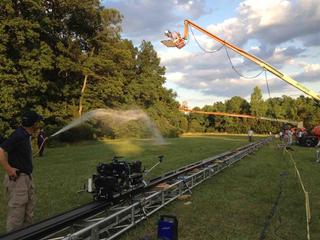Sound Devices Pix 240 Keeps Pace With Cheetahs for NatGeo

LOS ANGELES — When National Geographic magazine challenged Director of Photography Greg Wilson to create a shot tracking a sprinting cheetah, he turned to the Sound Devices PIX 240 Production Video Recorder for the shoot’s dailies, monitoring and backup.
Combining the resources of National Geographic and the Cincinnati Zoo, Wilson and his team captured motion pictures as well as high-res stills. Employing a Phantom Flex high-speed camera filming at 1200 to 1600 frames per second, the team captured the animal’s movement as it reached speeds of more than 60 miles per hour. For the still images, the crew used three Canon EOS-1D X digital cameras at full resolution.
“I needed to move a camera system, configured with the Phantom camera and the three Canon 1D X cameras, all at the same speed,” Wilson said. “When in action, we needed to reach 65 mph in 40 feet, hold that speed for 300 feet and then decelerate safely back to a complete stop.”
Wilson and his crew teamed up with Doggicam Systems in Los Angeles to design and build the custom dolly system that would move the camera along the 410-foot track. Using a modified version of its Super Slider System and a Sparrow 200 remote head, along with high-powered motion control motors provided by Romano Stunts, the camera was able to reach a speed of more than 65 mph in less than three seconds and then return to a resting position.
Wilson’s first AC and Phantom technician Edward Richardson built a control unit for the DSLRs. “This allowed them to run in sequence at 14 fps with zero overlap of the images and a perfect cadence, allowing us to capture, effectively, 42 fps at 18.1 megapixels per frame,” notes Wilson. “We were operating with a very small crew and didn't have the resources for a standard video tape recorder in the field, so we used the Sound Devices PIX 240.”
Richardson says that he and the crew wanted the ability to reference any shot over the three-day job. “With the PIX 240…we had an ongoing library of all the takes.” “The cats were a bit unsure around the camera once a run was over, so we couldn’t move the camera from the end of the track until the cheetah was relaxed, which sometimes took up to an hour,” Richardson said. “This presented a problem with saving the take. If the Phantom loses power before a take is saved, the footage is lost.” To resolve this, Richardson used the battery-powered PIX 240 as a recorder and portable monitor. “Another bonus is that we then had another backup of the footage,” he says.
Another major challenge was syncing the dolly system with a wild animal. The cheetahs would chase a lure/bait attached to a long line, using a hand controlled on/off switch held by one of the cheetah handlers. A quarter of a second or a few feet per second off could result the gear being a hundred feet off by the time the cat hit the lit area of the track.
Another major challenge was syncing the dolly system with a wild animal. The cheetahs would chase a lure/bait attached to a long line, using a hand controlled on/off switch held by one of the cheetah handlers. A quarter of a second or a few feet per second off could result the gear being a hundred feet off by the time the cat hit the lit area of the track.
“Sound Devices gave us the opportunity to have a small monitor and recording device in an all-in-one product, which I could use to show the cheetah handlers our progress as we were shooting,” Wilson said. “I don’t like to have many monitors on set, so the PIX 240 was perfect because I could have it around my neck or on the cart and show the people not working by the main monitors what we had captured.”
The story appeared in the November 2012 edition of National Geographic. The video footage can be found online.
Sound Devices’ PIX 240 is a companion to a range of professional cameras. Its five-inch, IPS-based LCD display is an accurate field monitor, provides users with immediate confirmation of framing, exposure, focus, audio metering and setup menu selections. It offers excellent color accuracy and contrast, great off-axis visibility and accurate motion tracking. PIX 240 and 240i users have the ability to record in Apple ProRes 4444, which offers impressive quality with 4:4:4 sources and workflows involving alpha channel transparency. With its 12-bit, 4:4:4 capability, the PIX 240 and 240i can record 330-Mbps Apple ProRes 4444 files that are perceptually indistinguishable from the original source material. Additional new features available in the latest v3.0 firmware include time-code and recording status displays on the SDI and HDMI outputs, up to 500 ms of audio delay to compensate for multi-device picture delay and selectable 4:4:4 or 4:2:2 video output independent from the source material.
Get the TV Tech Newsletter
The professional video industry's #1 source for news, trends and product and tech information. Sign up below.
